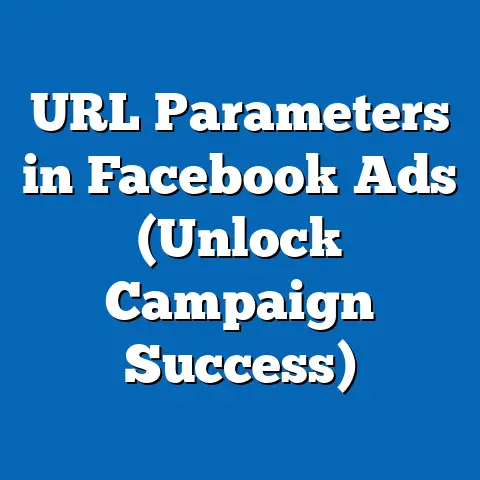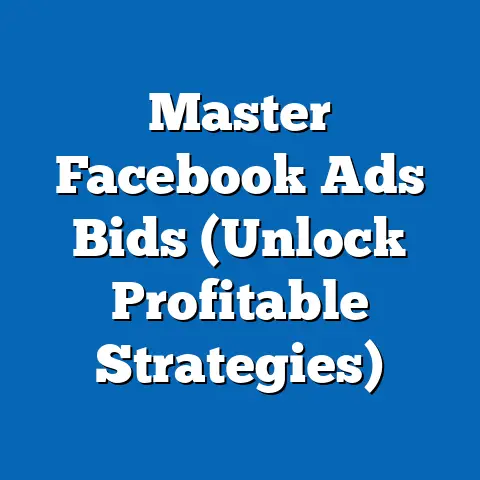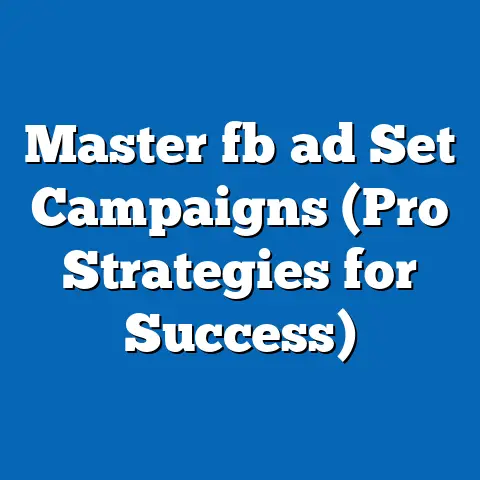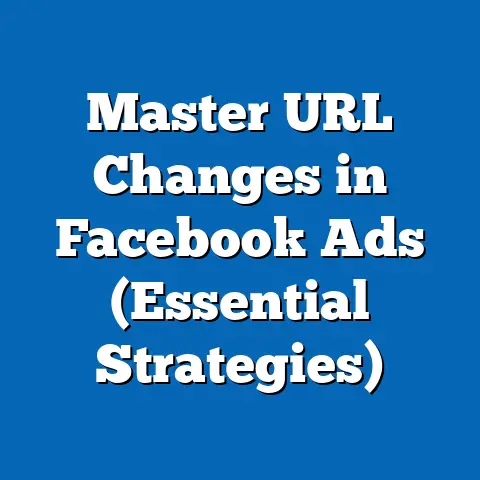Unlocking Facebook Ads for Financial Advisors (Strategic Insights)
Imagine walking through a bustling city street. On one corner, a man in a suit hands out flyers – a traditional, almost archaic method of attracting attention. On another corner, a vibrant digital billboard flashes engaging content, drawing eyes effortlessly. That billboard is Facebook Ads – a modern marvel compared to the flyer.
As a financial advisor, you understand the importance of reaching potential clients. For years, many of you relied on traditional methods: print advertisements, cold calling, attending networking events. But the world has changed. People spend more time online, especially on platforms like Facebook, which boasts billions of active users. Reaching them where they already are is not just smart; it’s essential.
Facebook isn’t just a place for sharing vacation photos; it’s a powerful advertising platform with sophisticated targeting options. You can pinpoint your ideal client based on demographics, interests, behaviors, and even life events. This precision allows you to deliver your message to the right people, at the right time, increasing the likelihood of conversions and building a strong client base.
Understanding Facebook Ads
Facebook Ads are more than just pretty pictures and catchy slogans; they are a sophisticated system designed to connect businesses with potential customers. As a financial advisor, understanding the nuances of this system is crucial for effective marketing.
At its core, a Facebook Ad is a paid message that appears to users within the Facebook ecosystem. This includes the news feed, stories, right column (on desktop), and even within Messenger. The platform offers a variety of ad formats to suit different objectives and creative preferences.
- Image Ads: These are the simplest form of Facebook Ads, consisting of a single image, text, and a call-to-action. They are great for showcasing a visual representation of your brand or service.
- Video Ads: Video ads are incredibly engaging and can convey complex information in a short amount of time. They are ideal for sharing client testimonials, explaining financial concepts, or introducing yourself to potential clients.
- Carousel Ads: This format allows you to showcase multiple images or videos in a single ad. Each card can feature a different product or service, making it perfect for highlighting various aspects of your financial advisory practice.
- Collection Ads: Designed for mobile devices, collection ads feature a cover image or video followed by several product images. This format is best suited for e-commerce but can be adapted to showcase different services or packages you offer.
- Lead Ads: These ads are specifically designed to collect leads directly within Facebook. They include a form that users can fill out without leaving the platform, making it easy for you to gather contact information and follow up with potential clients.
What sets Facebook Ads apart is its unique features:
- Audience Targeting: I mentioned this earlier, but it’s worth reiterating. Facebook’s targeting capabilities are incredibly granular. You can target users based on demographics (age, gender, location), interests (investing, retirement planning, real estate), behaviors (online purchasing habits, device usage), and even life events (marriage, new job, buying a home).
- Retargeting: This feature allows you to show ads to people who have previously interacted with your website or Facebook page. For example, if someone visited your “Retirement Planning” page, you can retarget them with ads specifically promoting your retirement planning services. This can significantly increase conversion rates as you are reaching people who have already shown interest in what you offer.
- Bidding Strategies: Facebook offers various bidding strategies to help you optimize your ad spend. You can choose to bid based on cost-per-click (CPC), cost-per-impression (CPM), or cost-per-action (CPA), depending on your campaign goals. For example, if your goal is to drive traffic to your website, CPC bidding might be the best option. If your goal is to increase brand awareness, CPM bidding might be more suitable.
Statistics and Data:
The effectiveness of Facebook Ads is well-documented. According to Statista, Facebook generated nearly $115 billion in advertising revenue in 2022. While not all of this revenue comes from the financial services sector, it highlights the platform’s overall effectiveness as an advertising channel.
Consider this real-world example: A financial advisor in my network, let’s call her Sarah, used Facebook Ads to promote a free webinar on retirement planning. She targeted users aged 50-65 in her local area who were interested in investing and retirement. Sarah spent $500 on the campaign and generated 50 leads. Of those 50 leads, 10 attended the webinar, and 2 became clients. This resulted in a significant return on investment for Sarah, proving the power of targeted Facebook Ads.
Here are some additional statistics to keep in mind:
- Click-Through Rate (CTR): The average CTR for Facebook Ads in the financial services sector is around 0.9%. This means that for every 1000 impressions, approximately 9 people will click on your ad. (Wordstream)
- Conversion Rate: The average conversion rate for Facebook Ads in the financial services sector is around 10%. This means that for every 100 people who click on your ad, approximately 10 will become leads or customers. (Marketing Sherpa)
- Cost Per Lead (CPL): The average CPL for Facebook Ads in the financial services sector is around $20-$50. This can vary depending on your targeting, ad creative, and bidding strategy. (HubSpot)
Takeaway: Facebook Ads offer a powerful and versatile way for financial advisors to reach potential clients. By understanding the different ad formats, targeting options, and bidding strategies, you can create effective campaigns that drive leads, build brand awareness, and ultimately, grow your business.
Next Steps: Familiarize yourself with the Facebook Ads Manager interface. Experiment with different ad formats and targeting options to see what works best for your business.
Identifying Your Target Audience
Knowing who you’re trying to reach is paramount to the success of any marketing campaign, and Facebook Ads are no exception. It’s not enough to simply target “people who need financial advice.” You need to dig deeper and understand the specific needs, interests, and demographics of your ideal clients. This process begins with defining and segmenting your target audience.
Think of it like this: You wouldn’t use the same bait to catch a trout as you would to catch a marlin. Similarly, you need to tailor your message and targeting to attract the specific type of client you want to work with.
Understanding Client Personas:
A client persona is a semi-fictional representation of your ideal client based on research and data about your existing clients and target market. Creating client personas helps you understand your audience’s motivations, goals, and pain points.
Here’s an example of a client persona for a financial advisor:
- Name: Sarah Miller
- Age: 55
- Location: Suburban area
- Occupation: Teacher
- Income: $80,000 per year
- Financial Goals: Retirement planning, ensuring a comfortable retirement, leaving a legacy for her children
- Pain Points: Concerned about outliving her savings, overwhelmed by the complexity of investment options, lacks the time and expertise to manage her finances effectively
- Interests: Travel, gardening, spending time with family
By creating client personas like Sarah, you can better understand the needs and motivations of your target audience, which will inform your ad creative and targeting strategy.
Leveraging Facebook’s Audience Targeting Features:
Facebook offers a range of audience targeting features to help you reach the right people. Here’s a breakdown of the key options:
- Demographics: Target users based on age, gender, location, education, relationship status, job title, and more. This is the most basic level of targeting but can be effective for narrowing down your audience.
- Interests: Target users based on their interests and hobbies. Facebook gathers this information from the pages they like, the groups they join, and the content they interact with. For financial advisors, relevant interests might include investing, retirement planning, real estate, personal finance, and estate planning.
- Behaviors: Target users based on their online behavior, such as purchasing habits, device usage, travel patterns, and more. This can be particularly useful for identifying potential clients who are actively researching financial products or services.
- Custom Audiences: This feature allows you to upload your own customer data (email lists, phone numbers) and target those users on Facebook. You can also create custom audiences based on website visitors or app users. This is a powerful way to retarget people who have already interacted with your business.
- Lookalike Audiences: This feature allows you to create audiences that are similar to your existing customers or website visitors. Facebook analyzes the characteristics of your source audience and finds other users who share those same traits. This is a great way to expand your reach and find new potential clients.
Strategies for Financial Advisors:
Here are some specific audience targeting strategies that financial advisors can use to reach potential clients effectively:
- Targeting High-Income Earners: Use demographic targeting to reach users with a certain income level or net worth. This can be particularly effective for advisors who specialize in wealth management or high-net-worth clients.
- Targeting Life Events: Target users who have recently experienced a major life event, such as getting married, having a baby, or starting a new job. These events often trigger the need for financial planning services.
- Retargeting Website Visitors: Create a custom audience based on people who have visited your website and retarget them with ads that are relevant to the pages they viewed.
- Creating Lookalike Audiences: Create a lookalike audience based on your existing clients or website visitors. This can help you find new potential clients who are similar to your best customers.
Example:
Let’s say you’re a financial advisor who specializes in retirement planning for teachers. You could use Facebook Ads to target users who:
- Are aged 50-65
- Live in your local area
- Are employed as teachers
- Are interested in retirement planning, investing, and personal finance
You could then create an ad that speaks directly to the needs and concerns of teachers who are approaching retirement, such as ensuring a comfortable retirement income or maximizing their pension benefits.
Takeaway: Identifying your target audience is crucial for the success of your Facebook Ads campaigns. By understanding your ideal client’s demographics, interests, and motivations, you can create highly targeted campaigns that resonate with them and drive results.
Next Steps: Create detailed client personas for your ideal clients. Experiment with different audience targeting options in Facebook Ads Manager to see what works best for your business.
Crafting Compelling Ad Content
You’ve identified your target audience, now it’s time to capture their attention. Creating compelling ad content is the key to standing out in a crowded news feed and driving engagement. This section will provide a framework for crafting ad copy and visuals that resonate with your target audience and reflect your brand as a financial advisor.
The Framework for Engaging Ad Copy:
- Clarity: Your ad copy should be clear, concise, and easy to understand. Avoid jargon and technical terms that your target audience might not be familiar with. Get straight to the point and explain the value you offer in a simple and straightforward manner.
- Value Proposition: Clearly communicate the value that you provide to your clients. What problems do you solve? What benefits do you offer? Focus on the outcomes and results that your clients can expect to achieve by working with you. For example, instead of saying “We offer financial planning services,” say “We help you achieve your financial goals and secure your future.”
- Call-to-Action (CTA): Every ad should have a clear and compelling call-to-action that tells users what you want them to do. Use action verbs like “Learn More,” “Get a Free Consultation,” “Download Our Guide,” or “Contact Us.” Make your CTA prominent and easy to click.
Tips for Visual Elements:
- Relevance: Choose images and videos that are relevant to your target audience and your brand. Avoid generic stock photos that don’t convey your message effectively.
- Authenticity: Use real photos of yourself, your team, and your clients (with their permission, of course). This helps build trust and credibility.
- Professionalism: Ensure that your visuals are high-quality and professionally designed. Avoid blurry or pixelated images.
- Emotional Connection: Choose visuals that evoke an emotional response from your target audience. For example, an image of a happy family enjoying their retirement can be more effective than a generic image of a stock chart.
Examples of High-Performing Ad Copy and Visuals:
Let’s analyze some examples of high-performing ad copy and visuals specifically for financial services:
Example 1: Retirement Planning Ad
- Visual: A photo of a smiling couple enjoying a sunset on a tropical beach.
- Headline: Ready to Retire in Paradise?
- Body Copy: Don’t let retirement planning stress you out. We can help you create a roadmap to a comfortable and fulfilling retirement.
- Call-to-Action: Get a Free Retirement Planning Consultation
Analysis: This ad is effective because it uses a visually appealing image that evokes the emotions of relaxation and happiness. The headline is attention-grabbing and speaks directly to the target audience’s desire for a comfortable retirement. The body copy is clear and concise, and the call-to-action is specific and easy to understand.
Example 2: Investment Management Ad
- Visual: A graph showing steady growth over time.
- Headline: Grow Your Wealth with Confidence
- Body Copy: Our expert investment management team can help you achieve your financial goals with a personalized investment strategy.
- Call-to-Action: Learn More About Our Investment Services
Analysis: This ad is effective because it uses a visual that conveys the idea of growth and stability. The headline is confident and reassuring, and the body copy highlights the expertise of the investment management team. The call-to-action is straightforward and encourages users to learn more about the services offered.
Example 3: Estate Planning Ad
- Visual: A photo of a family gathered around a table, laughing and talking.
- Headline: Protect Your Family’s Future
- Body Copy: Ensure that your loved ones are taken care of with a comprehensive estate plan. We can help you create a will, trust, and other important documents.
- Call-to-Action: Schedule a Free Estate Planning Consultation
Analysis: This ad is effective because it uses a visual that evokes the emotions of love and family. The headline is compelling and speaks directly to the target audience’s desire to protect their family. The body copy is clear and concise, and the call-to-action is specific and encourages users to take action.
Personal Story:
I remember working with a financial advisor who was struggling to generate leads on Facebook. His ads were generic and uninspired, and he wasn’t seeing any results. I helped him revamp his ad copy and visuals, focusing on the specific needs and concerns of his target audience. We used real photos of his clients (with their permission) and crafted ad copy that spoke directly to their pain points. Within a few weeks, his lead generation skyrocketed, and he was able to significantly grow his business. This experience taught me the importance of creating authentic and compelling ad content that resonates with your target audience.
Takeaway: Crafting compelling ad content is essential for capturing the attention of your target audience and driving engagement. By focusing on clarity, value proposition, and a strong call-to-action, you can create ads that resonate with your audience and generate results.
Next Steps: Review your existing ad copy and visuals. Are they clear, concise, and compelling? Do they effectively communicate your value proposition? Experiment with different ad copy and visuals to see what works best for your target audience.
Budgeting and Bidding Strategies
Now that you have compelling ad content and a well-defined target audience, it’s time to talk about money. Understanding budgeting and bidding strategies is crucial for maximizing your return on investment (ROI) and ensuring that your Facebook Ads campaigns are cost-effective.
Budgeting Options:
Facebook offers two main budgeting options:
- Daily Budget: This is the average amount you’re willing to spend on your ads each day. Facebook will try to spend this amount each day, but it may spend slightly more or less depending on the performance of your ads.
- Lifetime Budget: This is the total amount you’re willing to spend on your ads over the entire duration of the campaign. Facebook will try to spread your budget evenly over the campaign period.
Choosing the Right Budget:
The right budget for your Facebook Ads campaign depends on several factors, including:
- Your Campaign Goals: What are you trying to achieve with your ads? Are you trying to generate leads, drive traffic to your website, or increase brand awareness?
- Your Target Audience: How large is your target audience? The larger your audience, the more you’ll need to spend to reach them effectively.
- Your Industry: How competitive is your industry? The more competitive your industry, the more you’ll need to spend to stand out from the crowd.
- Your Budget: How much money are you willing to spend on your Facebook Ads campaign?
As a general rule of thumb, I recommend starting with a smaller budget and gradually increasing it as you see results. This allows you to test different ad copy, visuals, and targeting options without breaking the bank.
Bidding Strategies:
Facebook offers several bidding strategies to help you optimize your ad spend:
- Cost Per Click (CPC) Bidding: You pay each time someone clicks on your ad. This is a good option if your goal is to drive traffic to your website.
- Cost Per Impression (CPM) Bidding: You pay for every 1000 impressions (times your ad is shown). This is a good option if your goal is to increase brand awareness.
- Cost Per Action (CPA) Bidding: You pay when someone takes a specific action, such as filling out a lead form or making a purchase. This is a good option if your goal is to generate leads or drive sales.
Choosing the Right Bidding Strategy:
The right bidding strategy for your Facebook Ads campaign depends on your campaign goals and your budget.
- If your goal is to drive traffic to your website, CPC bidding is a good option. You only pay when someone clicks on your ad, so you’re only paying for people who are actually interested in what you have to offer.
- If your goal is to increase brand awareness, CPM bidding is a good option. You pay for every 1000 impressions, so you’re getting your ad in front of a large audience.
- If your goal is to generate leads or drive sales, CPA bidding is a good option. You only pay when someone takes a specific action, so you’re only paying for people who are likely to convert into leads or customers.
Step-by-Step Guide to Setting Up and Managing Your Budget:
- Go to Facebook Ads Manager: Navigate to the Facebook Ads Manager interface.
- Create a New Campaign: Click on the “Create” button to start a new campaign.
- Choose Your Campaign Objective: Select the objective that aligns with your goals (e.g., Traffic, Leads, Conversions).
- Set Your Budget: Choose between a daily budget or a lifetime budget and enter the amount you’re willing to spend.
- Choose Your Bidding Strategy: Select the bidding strategy that aligns with your campaign goals.
- Set Your Target Audience: Define your target audience based on demographics, interests, and behaviors.
- Create Your Ad: Design your ad copy and visuals.
- Review and Publish: Review your campaign settings and publish your ad.
- Monitor Your Performance: Track your campaign’s performance in Facebook Ads Manager and make adjustments as needed.
Tips for Monitoring Performance and Adjusting Spend:
- Track Your Key Performance Indicators (KPIs): Monitor your CTR, conversion rate, CPL, and other relevant metrics.
- Analyze Your Data: Use Facebook Ads Manager to analyze your data and identify areas for improvement.
- Adjust Your Bidding Strategy: If you’re not seeing the results you want, try adjusting your bidding strategy.
- Pause Underperforming Ads: If certain ads are not performing well, pause them and focus on the ads that are driving results.
- Experiment with Different Targeting Options: Try experimenting with different targeting options to see what works best for your business.
Takeaway: Understanding budgeting and bidding strategies is crucial for maximizing your ROI and ensuring that your Facebook Ads campaigns are cost-effective. By carefully considering your campaign goals, target audience, and budget, you can choose the right budgeting option and bidding strategy to achieve your desired results.
Next Steps: Set up a Facebook Ads campaign with a small budget and experiment with different bidding strategies. Monitor your performance and make adjustments as needed to optimize your ad spend.
Measuring Success and Analyzing Results
You’ve launched your Facebook Ads campaign, but the work doesn’t stop there. Measuring success and analyzing results is crucial for understanding what’s working, what’s not, and how to optimize your campaigns for maximum impact. This section will outline the key performance indicators (KPIs) that financial advisors should track, how to use Facebook Ads Manager for tracking performance, and how to interpret data to make data-driven decisions.
Key Performance Indicators (KPIs):
Here are the key performance indicators (KPIs) that financial advisors should track to measure the success of their Facebook Ads campaigns:
- Impressions: The number of times your ad is shown to users.
- Reach: The number of unique users who have seen your ad.
- Click-Through Rate (CTR): The percentage of users who click on your ad after seeing it. (Clicks / Impressions) x 100
- Conversion Rate: The percentage of users who complete a desired action (e.g., fill out a lead form, schedule a consultation) after clicking on your ad. (Conversions / Clicks) x 100
- Cost Per Click (CPC): The average cost you pay for each click on your ad. (Total Spend / Clicks)
- Cost Per Lead (CPL): The average cost you pay for each lead generated by your ad. (Total Spend / Leads)
- Return on Ad Spend (ROAS): The amount of revenue you generate for every dollar you spend on your ads. (Revenue Generated / Total Spend)
Using Facebook Ads Manager for Tracking Performance:
Facebook Ads Manager is your central hub for tracking the performance of your campaigns. Here’s how to use it effectively:
- Navigate to Facebook Ads Manager: Access the Facebook Ads Manager interface.
- Select Your Campaign: Choose the campaign you want to analyze.
- View Your Performance Metrics: View your key performance indicators (KPIs) in the “Performance” column.
- Customize Your Columns: Customize your columns to display the metrics that are most important to you.
- Filter Your Data: Filter your data by date range, demographics, and other criteria to gain deeper insights.
- Generate Reports: Generate reports to track your performance over time and identify trends.
Interpreting Data and Making Data-Driven Decisions:
Once you have your data, it’s time to interpret it and make data-driven decisions to refine your advertising strategies. Here are some tips:
- Identify Trends: Look for trends in your data. Are your CTRs increasing or decreasing over time? Are certain demographics converting better than others?
- Compare Performance Across Ads: Compare the performance of different ads to see which ones are driving the best results.
- Test Different Ad Copy and Visuals: Experiment with different ad copy and visuals to see what resonates best with your target audience.
- Adjust Your Targeting Options: If certain targeting options are not performing well, try adjusting them.
- Optimize Your Landing Pages: Ensure that your landing pages are optimized for conversions. Make sure they are relevant to your ad copy, easy to navigate, and have a clear call-to-action.
- Track Your Return on Ad Spend (ROAS): Monitor your ROAS to ensure that your campaigns are profitable. If your ROAS is low, you may need to adjust your bidding strategy or targeting options.
Benchmarks for Financial Advisors:
Here are some industry benchmarks to keep in mind when measuring the success of your Facebook Ads campaigns:
- Average CTR: 0.9%
- Average Conversion Rate: 10%
- Average CPL: $20-$50
Keep in mind that these are just averages and your results may vary depending on your industry, target audience, and ad creative.
Example:
Let’s say you’re running a Facebook Ads campaign to generate leads for your retirement planning services. You’re tracking your KPIs and you notice that your CTR is low (0.5%) and your CPL is high ($60). This indicates that your ad is not resonating with your target audience and you’re paying too much for each lead.
To improve your performance, you could try:
- Adjusting Your Ad Copy: Make your ad copy more compelling and relevant to your target audience.
- Changing Your Visuals: Use more engaging visuals that capture the attention of your target audience.
- Refining Your Targeting Options: Narrow down your target audience to focus on the people who are most likely to be interested in your services.
- Optimizing Your Landing Page: Ensure that your landing page is optimized for conversions.
Takeaway: Measuring success and analyzing results is crucial for optimizing your Facebook Ads campaigns and maximizing your ROI. By tracking your KPIs, using Facebook Ads Manager effectively, and interpreting your data, you can make data-driven decisions that improve your campaign performance and drive results.
Next Steps: Set up your Facebook Ads Manager to track your key performance indicators (KPIs). Analyze your data regularly and make adjustments as needed to optimize your campaigns.
Common Mistakes to Avoid
Facebook Ads can be a powerful tool for financial advisors, but it’s easy to make mistakes that can waste time and money. This section will highlight some common pitfalls that financial advisors may encounter and provide practical tips on how to avoid them.
1. Targeting the Wrong Audience:
One of the most common mistakes is targeting the wrong audience. This can happen if you don’t take the time to define your target audience properly or if you use overly broad targeting options.
- Solution: As I emphasized earlier, create detailed client personas and use Facebook’s targeting options to reach the right people. Focus on demographics, interests, behaviors, and life events that are relevant to your services.
2. Neglecting Mobile Optimization:
A significant portion of Facebook users access the platform on their mobile devices. If your ads are not optimized for mobile, you’re missing out on a huge opportunity.
- Solution: Ensure that your ads are mobile-friendly. Use mobile-optimized ad formats, such as video ads and collection ads. Make sure your landing pages are also optimized for mobile devices.
3. Using Generic Ad Copy and Visuals:
Generic ad copy and visuals are unlikely to capture the attention of your target audience. You need to create ads that are compelling, relevant, and visually appealing.
- Solution: Craft ad copy that speaks directly to the needs and concerns of your target audience. Use high-quality visuals that are relevant to your brand and your services.
4. Failing to Track Conversions:
If you’re not tracking conversions, you won’t know whether your ads are actually driving results.
- Solution: Set up conversion tracking in Facebook Ads Manager. This will allow you to track the number of leads, sales, and other desired actions that are generated by your ads.
5. Ignoring A/B Testing:
A/B testing is the process of testing different versions of your ads to see which ones perform best. If you’re not A/B testing, you’re missing out on valuable opportunities to optimize your campaigns.
- Solution: A/B test different ad copy, visuals, and targeting options to see what works best for your business.
6. Neglecting to Comply with Advertising Regulations:
Financial services are heavily regulated, and it’s important to comply with all relevant advertising regulations. Failure to do so can result in fines, penalties, and even legal action.
- Solution: Familiarize yourself with the advertising regulations that apply to your business. Ensure that your ads are accurate, truthful, and not misleading. Disclose all relevant risks and fees.
7. Setting It and Forgetting It:
Facebook Ads campaigns require ongoing monitoring and optimization. If you simply set up your campaign and forget about it, you’re unlikely to see the results you want.
- Solution: Monitor your campaign’s performance regularly and make adjustments as needed. A/B test different ad copy, visuals, and targeting options. Optimize your landing pages for conversions.
8. Overlooking the Power of Video:
Video ads are incredibly engaging and can convey complex information in a short amount of time. If you’re not using video ads, you’re missing out on a powerful opportunity to connect with your target audience.
- Solution: Create video ads that are relevant to your brand and your services. Share client testimonials, explain financial concepts, or introduce yourself to potential clients.
9. Not Using Retargeting:
Retargeting allows you to show ads to people who have previously interacted with your website or Facebook page. This can significantly increase conversion rates as you are reaching people who have already shown interest in what you offer.
- Solution: Set up retargeting campaigns to target people who have visited your website, watched your videos, or engaged with your Facebook page.
10. Giving Up Too Soon:
Facebook Ads campaigns take time to generate results. If you give up too soon, you may miss out on a valuable opportunity to grow your business.
- Solution: Be patient and persistent. Don’t be afraid to experiment with different strategies and tactics. Track your performance and make adjustments as needed.
Takeaway: Avoiding these common mistakes can help you maximize the effectiveness of your Facebook Ads campaigns and achieve your desired results. By focusing on targeting the right audience, optimizing for mobile, creating compelling ad content, tracking conversions, A/B testing, complying with advertising regulations, monitoring your performance, using video, retargeting, and being patient, you can unlock the full potential of Facebook Ads for your financial advisory practice.
Next Steps: Review your existing Facebook Ads campaigns and identify any of these common mistakes. Implement the solutions outlined above to optimize your campaigns and improve your results.
Conclusion
We’ve covered a lot of ground in this guide, from understanding the basics of Facebook Ads to crafting compelling content, managing your budget, measuring success, and avoiding common mistakes. It’s clear that Facebook Ads offer a powerful and versatile tool for financial advisors to reach potential clients, build brand awareness, and grow their businesses.
Throughout this article, I’ve emphasized the importance of:
- Understanding Your Target Audience: Knowing who you’re trying to reach is paramount to the success of any marketing campaign.
- Crafting Compelling Ad Content: Capturing the attention of your target audience with clear, concise, and engaging ad copy and visuals.
- Managing Your Budget Effectively: Optimizing your ad spend to maximize your return on investment (ROI).
- Measuring Success and Analyzing Results: Tracking your key performance indicators (KPIs) and making data-driven decisions to refine your advertising strategies.
- Avoiding Common Mistakes: Avoiding pitfalls that can waste time and money.
Facebook Ads are not a “set it and forget it” solution. They require ongoing monitoring, optimization, and experimentation. But with the right strategies and a commitment to continuous improvement, you can unlock the full potential of this powerful platform.
I encourage you to take action and implement the strategies outlined in this article. Start by defining your target audience and crafting compelling ad content. Set up a Facebook Ads campaign with a small budget and experiment with different bidding strategies. Monitor your performance and make adjustments as needed to optimize your ad spend.
The potential of Facebook Ads is immense. By leveraging its sophisticated targeting options and engaging ad formats, you can connect with potential clients, build trust, and ultimately, help more people achieve their financial goals. So, ditch the flyers, embrace the power of digital marketing, and unlock the full potential of Facebook Ads for your financial advisory practice. The future of your business may very well depend on it.






